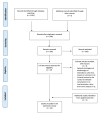The impacts of and outcomes from telehealth delivered in prisons: A systematic review
- PMID: 33999946
- PMCID: PMC8128277
- DOI: 10.1371/journal.pone.0251840
The impacts of and outcomes from telehealth delivered in prisons: A systematic review
Abstract
Background: While the delivery of healthcare services within prison systems is underpinned by different models, access to timely and optimal healthcare is often constrained by multifaceted factors. Telehealth has been used as an alternative approach to conventional care. To date, much of the focus has been on evaluation of telehealth interventions within certain geographical contexts such as rural and remote communities. Therefore, the aim of this systematic review was to synthesise the evidence base to date for the impacts of, and outcomes from, telehealth delivered in prisons.
Methods: This systematic review was underpinned by best practice in the conduct and reporting of systematic reviews. A systematic search was conducted to reinforce the literature selection process. The modified McMaster Critical Appraisal Tool was used to assess the methodological quality of the included studies. A narrative synthesis of the study outcomes was undertaken.
Results: Twenty-nine quantitative studies were included. Telehealth interventions were greatly varied in terms of types of healthcare services, implementation process and intervention parameters. Methodological concerns such as rigour in data collection and analysis, and psychometric properties of outcome measures were commonly identified. Process-related outcomes and telehealth outcomes were the two overarching categories identified.
Conclusion: This systematic review provides mixed evidence on the impact of, and outcomes from, telehealth in prisons. While the evidence base does highlight some positive impacts of telehealth, which at the least, is as effective as conventional care while achieving patient satisfaction, it is also important to consider the local context and drivers that may influence what, when and how telehealth services are provided. Addressing critical factors throughout the lifecycle of telehealth is equally important for successful implementation and sustainability.
Conflict of interest statement
The authors have declared that no competing interests exist.
References
-
- Jacobson J, Heard C, Fair H. Prison: Evidence of its use and over-use from around the world [Internet]. London: Institute for Criminal Policy Research; 2017 [cited 2021 Apr 8]. Available from https://www.prisonstudies.org/sites/default/files/resources/downloads/gl....
-
- Australian Institute of Health and Welfare. The health of Australia’s prisoners 2015 [Internet]. Canberra: AIHW; 2015 [cited 2021 Apr 8]. Available from https://www.aihw.gov.au/getmedia/9c42d6f3-2631-4452-b0df-9067fd71e33a/ai....
-
- Fazel S, Danesh J. Serious mental disorder in 23 000 prisoners: a systematic review of 62 surveys. The lancet. 2002;359(9306):545–50. - PubMed
-
- World Health Organisation [Internet]. Geneva: WHO; c2021 [cited 2020 Spe 9]. HIV in prisons; [about 6 screens]. Available from: https://www.euro.who.int/en/health-topics/communicable-diseases/hivaids/....
Publication types
MeSH terms
LinkOut - more resources
Full Text Sources
Other Literature Sources
Medical


